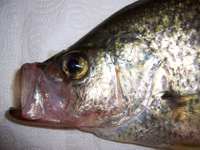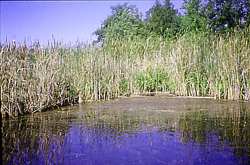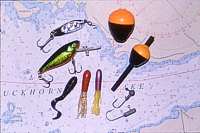|
"An Introduction to Springtime Crappies" By Justin
Hoffman
 We all as anglers have our special rites of spring. For
some it involves floating roe down a tributary stream for early
season steelies. Others enjoy the opportunity to lock horns with the
ice out water wolves that slowly cruise the shallows. My early
season angling is occupied by one specie and one specie only - and
that is Mr. Crappie. We all as anglers have our special rites of spring. For
some it involves floating roe down a tributary stream for early
season steelies. Others enjoy the opportunity to lock horns with the
ice out water wolves that slowly cruise the shallows. My early
season angling is occupied by one specie and one specie only - and
that is Mr. Crappie.
Crappies hold a certain soft spot in my heart. I admire their
tenacious fighting capabilities when using light line, their
chameleon-like habit of blending into the surrounding cover, and of
course, their exceptional taste when tossed in a pan with butter,
garlic and oil.
Follow me as I offer up some tips on finding and catching crappie
this coming spring.
Location is Key
Timing is everything when it comes to catching crappie, especially
at the start of the season. Once ice out occurs, there will be an
influx of crappie flooding the
 shallows. They have one thing on
their mind at this time, and that is to feed. The water during the
early goings will be too chilly to begin the process of spawning,
yet this migration to the shallows is often referred to as a "fake
spawn." This period of fishing can be hit and miss at best, as they
will usually only stick around for a week or two, then retreat back
to deeper water in anticipation of the oncoming warming trend. shallows. They have one thing on
their mind at this time, and that is to feed. The water during the
early goings will be too chilly to begin the process of spawning,
yet this migration to the shallows is often referred to as a "fake
spawn." This period of fishing can be hit and miss at best, as they
will usually only stick around for a week or two, then retreat back
to deeper water in anticipation of the oncoming warming trend.
As the water heats up, once again crappie will head to shallow
water. As soon as 66-68 degrees is reached, the spawn will commence.
Depending on the type of lake, and the attitude of the fish, most
crappie will stay on this shallow water pattern for the good part of
a month. It is this particular month that we are most interested in.
Shallow water can bring about many different connotations, but
there are certain attributes that consistently attract springtime
slabs. The first is depth. Search out areas that are 4 feet or less.
This shallow water will hold the highest concentration of fish, and
will help greatly in weeding out unproductive water.
The next thing to keep an eye out for is cover. Structure and
cover can come in many forms, but at the top of a crappies list are
cane and bulrushes, stumps and wood, man-made docks and pilings, as
well as scattered weed. The best spot I have ever located contained
a mixture of peat/mud with some wood thrown in - an ideal area for
digging nests while also offering safety and security.
Although you can catch crappie out and away from structure areas,
they do seem to prefer an object to lie beside or under. Old wooden
docks can be a gold mine, especially if the structure is low to the
surface of the water. Target the legs of the dock itself, as this
will be the primary location that the crappie will set up in. Trees
or branches that have fallen in the water are also at the top of my
list, and in my experience, evergreen branches or full coniferous
trees rate up there as number one.
Canals (both man and nature-made), shallow back bays and
shoreline areas are where you should be concentrating your searches
on. Keep in mind that south facing shorelines will warm the fastest,
so it pays to seek out these hotspots first thing in the season.
Putting Together a Game Plan
Before heading out and fishing blindly, a bit of preplanning and
homework can go a long way. Whatever body of water you intend to
fish, obtain a topographical map. Highlight the productive looking
spots, using depth, position of the areas and structure points as
your variables. Things to be conscious of are marinas (docks), bays
(south facing and shallow) and canals. These can all be easily
located on a map prior to launching, and can save you considerable
time when searching out fish.
I like to stick with clear water lakes. Clear water allows me to
visually see fish (lets you quickly know if fish are in the area),
see structure below the surface, and when everything comes together,
will give me the opportunity to sight fish for those big slabs.
Sight fishing is a very effective technique, as you actually can
pick and choose which fish to go after. I will generally cast
blindly less than 25% of my time in the spring, preferring to get a
fish in my sights, before gently lobbing a cast in his direction.
Stealth is part and parcel of the crappie game, and an electric
motor is certainly an asset when fishing the skinny water. Crappie
can spook easily at times, so make slow and quiet movements when
working your way through productive areas. It also goes without
saying that wearing a pair of polarized glasses is mandatory for
this shallow water fishing.
Stocking the Tackle Box
 The neat thing about chasing crappie is not having to rely on
expensive gear or bottomless tackle boxes. A 6 or 6.5-foot
ultralight spinning rod coupled with a small ultralight reel takes
care of the equipment side of the equation. Spool up with 4 or 6lb
test mono and you're pretty much good to go. The neat thing about chasing crappie is not having to rely on
expensive gear or bottomless tackle boxes. A 6 or 6.5-foot
ultralight spinning rod coupled with a small ultralight reel takes
care of the equipment side of the equation. Spool up with 4 or 6lb
test mono and you're pretty much good to go.
When it comes to baits, the plastic tube reigns supreme. Choose a
panfish-sized micro tube, and pair it up with 1/32 or 1/64 oz. jig
head. My most trusted colours have been white, pink, chartreuse,
brown, red and purple. Two-tone jigs allow you to use more than one
colour, upping your odds of discovering which combination works
best. I prefer to suspend my jigs below a slip float, paying close
attention to keep my plastics high as the crappie will always feed
upwards.
Small cranks and spinners can also work well, especially when
fish are aggressively guarding their nests, or when water
temperatures greatly increase. I've had a few banner outings that
included some true slabs - all falling prey to a small crank slowly
twitched along the surface of the water. I must say - it's pretty
exciting to see a crappie blast a topwater in a foot of water!
As you can see, chasing the crappie of spring certainly isn't a
complicated affair. In order to get in on the game, you have to know
where to look. Whether you head to the Kawartha's, Rice or the
mighty Ottawa, you can be assured of some fantastic early season
fishing - and that's what we all need after such a long, cold winter
of the white stuff. |